

Untitled. Untitled. Actualizado:18/04/2015 04:11h Guardar Es un hecho más que cierto que sabemos todavía muy poco de todo lo que nuestro cerebro es capaz de hacer. La ciencia está en pañales con respecto al mecanismo, prácticamente perfecto de nuestro cuerpo y, muy especialmente de nuestro cerebro. Sin embargo, cada día se descubren nuevas cosas, más fascinantes si cabe que las anteriores.
En el mundo femenino, en el de la maternidad, hay una discusión muy viva sobre el uso de la oxitocina sintética —también llamada la hormona del amor— en los partos. Irene García Perulero —bióloga e investigadora de esta hormona muy implicada en el desarrollo de las relaciones sexuales, amorosas y de reproducción y lactancia, en el ser humano—, recuerda que tuvo un parto muy complicado que terminó en cesárea.
Untitled. Psychedelic drugs expand the mind.

This is common knowledge among people who have experienced the sensory changes brought by psychoactive drugs such as psilocybin found in magic mushrooms. The effects of magic shrooms last up to 12 hours but according to an American ethnobotanist Terence McKenna, the effects of magic mushrooms on the sexual experience and human evolution are longer lasting and can be credited for the way society is the way it is today. McKenna authored the Stoned Ape theory of human evolution. This theory centers around how psilocybin mushrooms are responsible for lighting the fire of human intelligence and society. The Stoned Ape Theory has three stages. Untitled. A contact high is an experience of sensing or perceiving drug effects when in the company of someone who has actually taken drugs, without having taken the drug yourself.1 For example, an experienced acid (LSD) user who is spending recreational time with someone who is "tripping" on LSD may start to feel as if they, too, are under the influence of LSD.
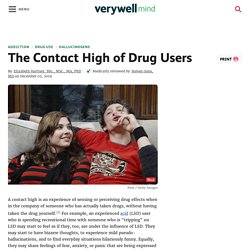
They may start to have bizarre thoughts, to experience mild pseudo-hallucinations, and to find everyday situations hilariously funny. Equally, they may share feelings of fear, anxiety, or panic that are being expressed by the other person. A contact high can also happen when someone has taken a placebo, or a substance containing no psychoactive ingredients2 — a common money-making drug dealers' trick — believing that they have taken a real drug when they are around others who really have taken the drug.
The term is sometimes loosely used to refer to the effects of secondhand marijuana smoke.3. Novelty and the Brain: Why New Things Make Us Feel So Good. Novelty Keeps Your Brain Healthy. Our brains love newness.
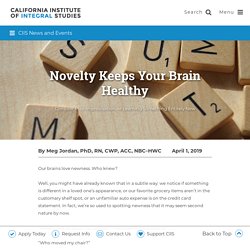
Who knew? Well, you might have already known that in a subtle way: we notice if something is different in a loved one’s appearance, or our favorite grocery items aren’t in the customary shelf spot, or an unfamiliar auto expense is on the credit card statement. In fact, we’re so used to spotting newness that it may seem second nature by now. “What’s that ding on my car door? Scientists Just Solved a Major Piece of the Opioid Puzzle. Problem loading page. The role of δ-opioid receptors in learning and memory underlying the development of addiction. Reward Processing by the Opioid System in the Brain. Neural Network. Nerve Pulses Pass by Each Other. The brain learns completely differently than we’ve assumed, new learning theory says. (credit: Getty) A revolutionary new theory contradicts a fundamental assumption in neuroscience about how the brain learns.
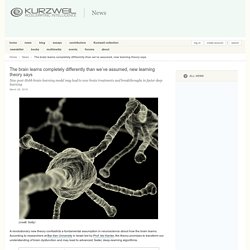
According to researchers at Bar-Ilan University in Israel led by Prof. Ido Kanter, the theory promises to transform our understanding of brain dysfunction and may lead to advanced, faster, deep-learning algorithms. A biological schema of an output neuron, comprising a neuron’s soma (body, shown as gray circle, top) with two roots of dendritic trees (light-blue arrows), splitting into many dendritic branches (light-blue lines).
The signals arriving from the connecting input neurons (gray circles, bottom) travel via their axons (red lines) and their many branches until terminating with the synapses (green stars). Pythagorean Tuning Forks 2/3 (256hz & 384hz) - healingsounds.com. These tuning forks represent a powerful new way of using sound to resonate the body, brain and etheric fields.
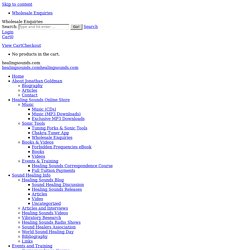
These tuning forks were developed by John Beaulieu, N.D., Ph.D., author of MUSIC AND SOUND IN THE HEALING ARTS. These specific tuning forks are of C (256 cycles per second) and G (384 cycles per second). They are of the musical interval (the name given when two notes are sounded together) called “the Perfect Fifth”. With these tuning forks, they are two harmonically related notes which vibrate against each other at the ratio of 2:3 (the C tuning fork vibrates two times as fast as an unstruck C of 128 cycles per second–the G tuning fork vibrates three times as fast as that unstruck C. Researchers Discover Neurons are Much More Flexible Than We Thought. It was once believed that memories are formed by hardwiring information into the brain in a highly stable manner.

However, recent studies carried out at Harvard Medical School (HMS) tell a different story. Researchers claim that this new information suggests that the neuronal networks are much more flexible than we first thought. This plasticity is what allows the networks to integrate new information easier and incorporate learning, without the need to form new links to different neurons every time. The study also confirmed that when a memory is no longer required, neurons are able to reassigned much more easy to do more important tasks.
On Flipboard. White matter: The brain's flexible but underrated superhighway. Nerve fibers regenerated with molecular mix. Good news, wannabe supervillains! Mind control is possible with magnetism. Surprising neural communication mechanism revealed. On Flipboard. The adult brain can regenerate neurons in an unexpected area, says new study. Scientists have discovered for the first time that adult mouse brains produce new cells in the amygdala, a finding that could eventually lead to better treatments for conditions like anxiety and depression, as well as a better understanding of the brain overall.
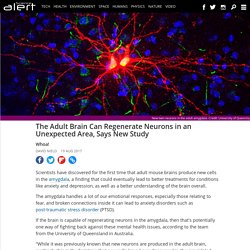
The amygdala handles a lot of our emotional responses, especially those relating to fear, and broken connections inside it can lead to anxiety disorders such as post-traumatic stress disorder (PTSD). If the brain is capable of regenerating neurons in the amygdala, then that's potentially one way of fighting back against these mental health issues, according to the team from the University of Queensland in Australia. Scientists just discovered new kinds of cells in the human brain. In Brief Researchers from the Salk Institute and the University of California San Diego have discovered a way to categorize neurons down to the molecular level.
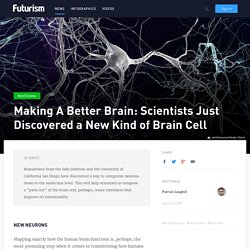
Thinking Too Much Can be Detrimental to Human Performance. Forgetting things could actually be making you smarter. New research suggests bouts of forgetfulness could be caused by a safety mechanism in the brain designed to make sure we're not overloaded with information.
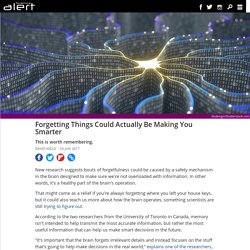
Scans Of One Handed People's Brains Challenge Theory On Neural Organization. Maps of the brain typically mark areas as being generally responsible for particular body parts.

Genes May Influence One's Ability To Read People’s Emotions From Their Eyes. Social situations reveal pretty quickly which people are just "naturally" better at reading other people's emotions than others. According to a new study published in the journal Molecular Psychiatry, this ability to read emotions just by looking at someone's eyes may be influenced by one's genes. The researchers from the University of Cambridge, UK, managed to pinpoint the genetic variants responsible for this sense of empathy. It was shown to be associated with genetic variants on chromosome 3 in women. Researchers Reveal The Multi-Dimensional Universe Of The Brain. The human brain is a convoluted labyrinth of passages in constant flux – routes are being created, strengthened, and deconstructed on a daily basis.
On top of this, there are billions of neurons communicating with each other all day, every day via these ever-changing passages. At their junctions, there are synapses – about 1 quadrillion of them. If this all sounds complicated enough, then add a mind-boggling 11 dimensions to the mix. Get ready, this new research is set to be a head-twister. Scientists just found the part of our brain that actually gets physics. Many science students might dread the more complex aspects of physics, but far removed from the mathematical equations that define how our physical world behaves, we each have an inner intuitive sense for how things will bounce, wobble, or fall. Now, researchers say they've identified the brain region responsible for making these instinctive, immediate calculations for the movement of physical objects, dubbing it the brain's "physics engine". "We run physics simulations all the time to prepare us for when we need to act in the world," says cognitive scientist Jason Fischer from Johns Hopkins University.
"It is among the most important aspects of cognition for survival. But there has been almost no work done to identify and study the brain regions involved in this capability. " Scientists just identified 97 brand-new regions in our brains. Scientists have created the most detailed map of the human brain ever, using brain scans of hundreds of people to identify almost 100 new regions in the cerebral cortex. While researchers have been charting the brain for over 150 years, the new map – which delineates 180 cortical areas – will give scientists unprecedented understanding of how we think, talk, and feel – and offer new insights into disorders like autism, schizophrenia, and dementia. Breakthrough Initiative Will Grow Organs and Regenerate Human Tissue.
Brain scans highlight a hidden, "higher" state of consciousness. Reaching a higher state of consciousness is a concept you're more likely to hear a spiritualist spout than a scientist, but now neuroscientists at the University of Sussex claim to have found the first evidence of just such a state. From wakefulness down to a deep coma, consciousness is on a sliding scale measured by the diversity of brain signals, and the researchers found that when under the influence of psychedelic drugs, that diversity jumps to new heights above the everyday baseline. The research builds on data gathered about a year ago by a team at Imperial College London, which dosed up volunteers with psychedelics, including LSD, psilocybin and ketamine, then scanned their brains with magnetoencephalographic (MEG) techniques to examine the effects.
On Flipboard. Study finds altered brain chemistry in people with autism. Music in the brain. Scientists have long wondered if the human brain contains neural mechanisms specific to music perception. A delicate balance between positive and negative emotion. Our emotional state is governed partly by a tiny brain structure known as the amygdala, which is responsible for processing positive emotions such as happiness, and negative ones such as fear and anxiety. How the brain recognizes faces. How the brain perceives rhythm. When it comes to perceiving music, the human brain is much more tuned in to certain types of rhythms than others, according to a new study from MIT. Rhythm of Breathing Affects Memory and Fear - Neuroscience News. Wiring of the 'little brain' linked to multiple forms of mental illness: Findings implicate brain regions known for helping coordinate complex movements. A Duke University study is the first to link specific differences in brain structure to what is common across many types of mental illness.
Having a single mental illness like anxiety, depression or schizophrenia is hard enough on its own. Are you listening? Your pupils indicate if you are: Study finds pupil dilation patterns synchronize during shared attention. 5 New Studies Report Previously Unknown Cerebellum Functions. Restorative Sleep Is Vital to Brain Health. MIT Scientists Identify Brain Circuits of Memory Formation. Brain cells we thought were just fillers might actually be the key to our body clocks. Scientists have discovered that brain cells that were once considered to be simple place-holders for neurons could actually play an important role in helping to regulate our circadian behaviour. Astrocytes are a kind of glial cell – the support cells that are often called the glue of the nervous system, as they provide structure and protection for neurons. Physicists discover an unexpected force acting on nanoparticles in a vacuum. Scientists Discover a Hidden Network of 'Mini Brains' That Could be Responsible for Pain.
We Just Created an Artificial Synapse That Can Learn Autonomously. Neuroscientists have accidentally discovered a whole new role for the cerebellum. Giant neurons from the claustrum found wrapped around mouse brains could explain the biological origin of consciousness — Quartz. Scientists just found evidence that neurons can communicate in a way we never anticipated.
Becoming Immortal: The Future of Brain Augmentation and Uploaded Consciousness. Basic algorithm that enables our intelligence discovered in brains. 9 Brainy Facts About the Neocortex. This world-first brain implant is letting a 'locked-in' woman communicate. Science AMA Series: I’m Dr. David Kimhy of Columbia Psychiatry. My study showed that an aerobic exercise program improved cognitive functioning in people with schizophrenia, and with increases in fitness and brain-derived neurotrophic factor, a protein in. Dentate gyrus basket cell. This single protein influences how your brain copes with stress - ScienceAlert.
10 Research-Based Truths About People in Love. THE PHOSPHOTRON - Seno(9007).pdf. What the Things You See When You Rub Your Eyes Are Called. Bypass commands from the brain to legs through a computer. Prepare to Be Shocked - Alexis C. Madrigal. 10 Scientific Studies That Prove Consciousness Can Alter Our Physical World. Fractal Geometry and its Correlation to the Efficiency of Biological Structures - viewcontent.cgi. Biologists Create 'Zombie Cells' In The Lab Which Outperform Living Counterparts. New Clues to Memory Formation May Help Better Treat Dementia. Evidence of Psilocybin “Magic Mushrooms” Growing New Brain Cells. Ballet Brain. Untitled. Decoding Space and Time in the Brain. Finding Injury. Eyes: a Window to the Diagnosis. Growing New Neurons.